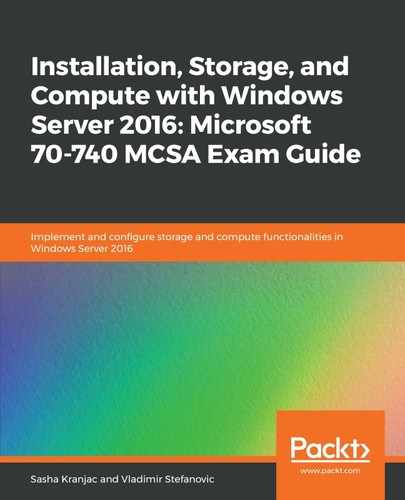The cluster quorum is really important for proper cluster functioning. The quorum function is responsible for voting in a cluster. Each cluster will be fully functional if 50.1% of nodes are up. Let's say we have a three-node cluster. If one node is down and two nodes are up, the cluster has a quorum because 66.6% of the nodes are up. If you have a two-node cluster, however, and one node goes down, the second node will work properly, even though only 50% of the nodes are up. However, if the network connectivity between nodes goes down and both nodes stay up, both nodes will declare themselves to be the primary node, which can cause a big problem in the data and the application. To avoid this scenario, you need to configure Quorum Witness. Witness only has a valid vote in scenarios where there are even numbers of nodes that can vote.
In Windows Server 2016, as well as earlier versions Windows Servers, there are four quorum modes:
- Node Majority: Each node that's available can vote
- Node and Disk Majority: Each node can vote, as can a designated disk witness
- Node and File Share Majority: Each node can vote, as can a designated file share witness
- No Majority: Disk Only: The cluster has quorum if one node is available and in communication with a specific disk in the cluster storage
Dynamic Quorum, as a new mode, was introduced in Windows Server 2012. Based on the nodes which appear online, this mode will dynamically adjust the quorum votes. Part of the Dynamic Quorum that came with Windows Server 2012 is Dynamic Witness. The witness will only vote if its vote is needed. Dynamic Quorum is set as a default configuration in Windows Server 2016 and there are three types of witness that you can choose from:
- Disk witness: Primary and most used in different scenarios.
- File share witness: Used as an alternative when there is no shared storage or when you can't use a disk as a witness.
- Azure Cloud witness: New functionality in Windows Server 2016. Microsoft Azure Blob Storage may be used to read or write a blob file.
A Cluster Quorum can be created using the Failover Cluster Manager console or PowerShell:
- Open the Failover Cluster Manager console and right-click on the previously created cluster.
- Select More Actions and then Configure Cluster Quorum Settings...:

Then you just need to follow the wizard and configure the quorum settings based on your needs.
